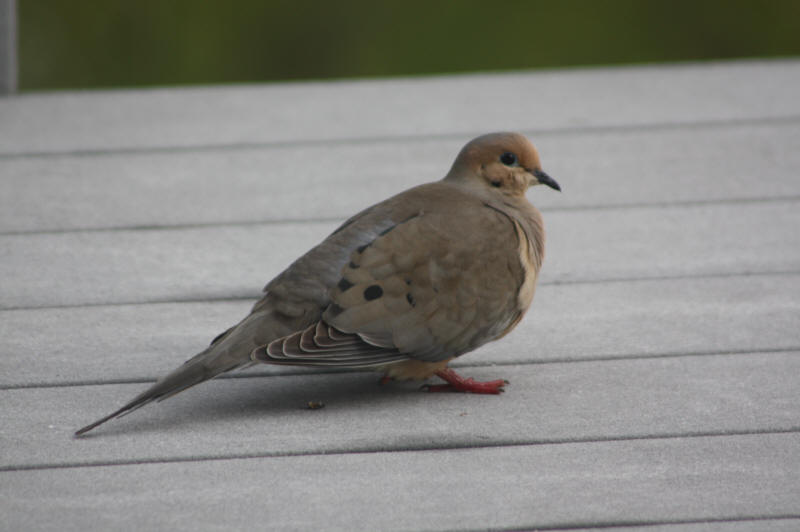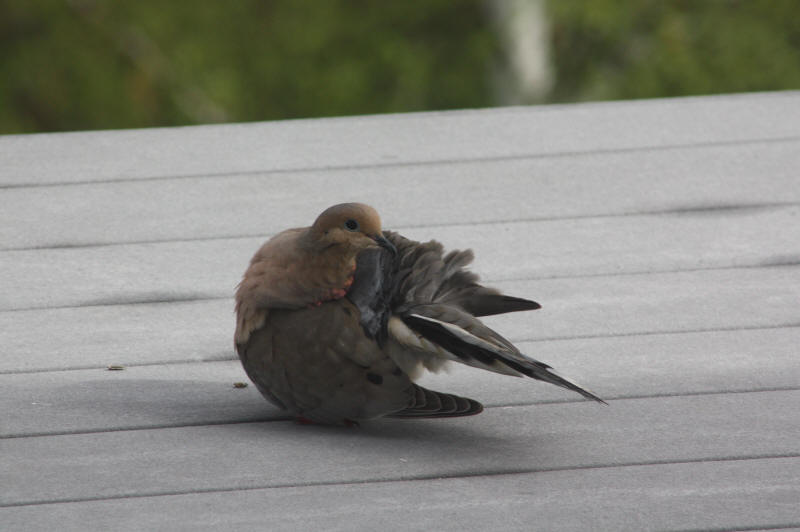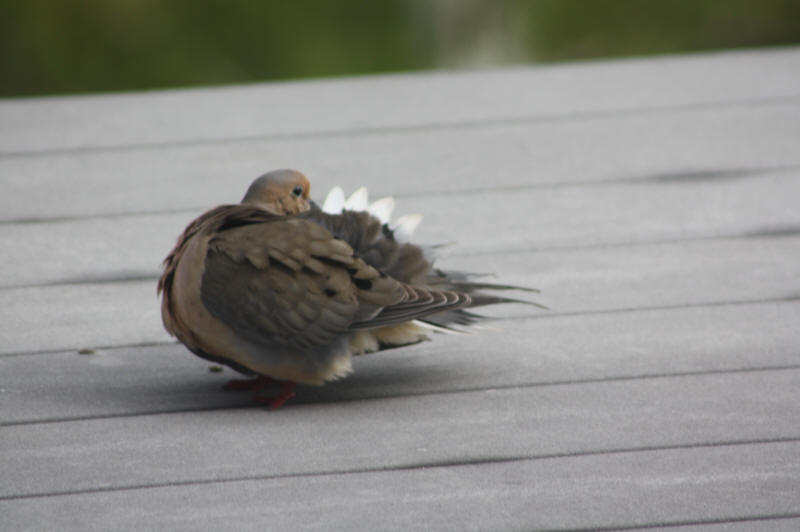|
 |
|
Home Page
More News |
|
In Da Woods |
|
by Melanie B. Fullman, US Forest Service |
 |
|
Doves: More than Meets the Eye
They are almost always here, on the ground beneath our
feeders in the winter and on the roof every summer’s
eve. I guess I ignore them because they are so common.
So it was with just a passing glance that I noticed one
the other day sitting on our deck, preening. The
sunlight must have been “just right” as I saw, for the
first time perhaps, the soft bright colors of the tail
and wings, the streamlined shape of the body, and the
grace with which it conducted itself. I was amazed and a
tad bit embarrassed for having discounted it (them) for
so long.
Bountiful Beauty
I know you’ve seen them, so I won’t spend much time on
the description: mourning doves have long, pointed tail,
short legs, and a head that looks a bit small in
comparison to their body. They are much more slender
than a rock dove (pigeon) and are the only North
American dove with a pointy tail. They weigh less than 6
oz., are about a foot long, and have a wingspan of 18”.
Coloring is a delicate brown to buffy-tan, with black
spots on the wings and white tips on the tail.
The swept back wing design is similar to that of
falcons, enabling them to fly very FAST and maneuver
quickly, making sudden climbs, descents, and dodges
(sometimes to escape the aforementioned falcons). Flight
speeds can exceed 50 mph.
Seeds from grain, peanuts, grass, trees (including
acorns and pine nuts), weeds, and herbs are 99% of a
Mourning Dove’s diet. They also eat berries and snails.
They feed exclusively on the ground, pecking or pushing
aside ground litter, but not really ‘scratching’ like
chickens. If bird feeders are present, mourning doves
congregate below, picking up dropped seeds and fallen
bits.
The food is “swallowed” into a pouch in their esophagus,
called a crop. Once the crop is filled (the record is
17,200 bluegrass seeds!), they fly to a safe perch to
digest their meal. To stay healthy, mourning doves must
eat 12-20%, about 71 calories, of their body weight
every day.
Mourning doves are unique in that they can drink
brackish water, containing almost half the salt level of
sea water, without becoming dehydrated. This allows them
to live in deserts, drinking water that would harm, or
kill, many other animals.
As a habitat generalist, mourning doves have generally
benefited from human changes to the North American
landscape. They
live nearly everywhere now except deep woods. Look for
them in open country with scattered trees, forest edges,
fields, parks, and on roofs and telephone wires in
cities. Males may have a favorite “cooing” perch that
they defend from other males.
The US population of mourning doves is currently
estimated at 350 million. Hunters harvest about 20
million per year, making them the most hunted species in
North America – actually more than
the annual harvest of all
other migratory game birds combined.
Although they are appear to be doing fine in the face of
this pressure, their foraging style puts them at risk of
additional ‘lead poisoning’ - from eating lead shot
pellets. Studies have found this problem worse around
fields planted to attract, and hunt, doves; about 1 in
20 wind up eating lead. Natural predators include
raccoons, hawks, owls, jays, squirrels, and snakes. |
 |
| |
|
Life & Times
Mourning doves mate for life, which ranges from a mere
12 months to 10 years; the oldest known Mourning Dove
was 31. Members of a pair keep their bond strong by
preening each other with gentle nibbles around the neck,
grasping beaks, and bobbing their heads up and down in
unison.
Nests are a flimsy assemblage of pine needles, twigs,
and grass stems, unlined and with little insulation for
their young. Both mates help build the nest, with the
male passing twigs to the female, while standing on her
back; she then weaves them into a nest about 8” across.
Doves will use existing nests, and don’t seem particular
whether it was their own.
Nests are most often built in dense foliage on a tree
branch. In the west, they frequently nest on the ground
and in urban area, in gutters, eaves, and abandoned
equipment. Simple nest baskets to attract doves to your
backyard are easy to make:
birds.cornell.edu/nestinginfo/downloads
then select Nesting Shelves & Platforms, or call me and
I’ll send them to you (932-1330 x539).
Two, white eggs are incubated for 14 days, with the
young leaving the nest in 2-3 weeks. The male usually
incubates the egg during the day and the female at
night. Under favorable weather conditions, adults may
re-breed and raise a new clutch every 30 or so days for
3+ months. Both adults feed
newly their hatched young “milk”, a unique secretion of
the cells of the crop wall.
During the breeding season, you may see three mourning
doves flying in tight formation, one after another. The
bird in the lead is generally the male of a mated pair.
The second bird is an unmated male with high hopes,
chasing rivals from the area where he hopes to nest. The
third is usually the female of the mated pair, following
along for, apparently, the entertainment.
Mourning doves are partial migrants: most breeding
populations in northern latitudes migrate, while those
living in the
central and southern US often
live there year-round. Northern birds often fly
thousands of miles, as far as southern Mexico, between
their wintering and breeding grounds.
Whistling Wings
In addition to the soft, drawn-out, and mournful “cooo,
cooo, coo”, you might have noticed a sharp whistling
sound they make as they fly. This is due to air moving
rapidly across a narrow outer feather on the wing, in
the same manner as sounds produced by blowing a whistle
or flute. Since pigeons and doves do not make vocal
alarm calls, scientists have long wondered if the wing
whistle serves that purpose instead, varying somehow in
is length, strength, or volume depending on the
circumstances. After all, frightened birds take off
faster and at a steeper angle than a calm bird moving
from place to place.
Researchers found the sound of the wing whistle of
startled birds was louder and faster than normal birds
(listen to both at
http://sciencenow.sciencemag.org/feature/data/wingsound.wav).
When normal wing whistles were played to flocks of
feeding pigeons, none responded. But when the same
flocks heard the wing whistle of startled birds, 11 of
15 flew off. The test was adjusted to account for the
greater volume in startled departures. As a result,
scientists recently concluded that it is the faster
tempo of the startled wing whistle, not the loudness
that signals alarm. Something to listen for on your next
outing or while tending your yard.
Hope to see YOU in the woods, and in the fields, too. |
 |
| |

Polar Bear
Cookbook
Thank you
to everyone who submitted
recipes for the Polar Bear
Hockey Cookbook. The cookbooks
are now available. The cost for
the cookbooks are $10.00 so make
sure to grab one for yourself
and maybe one or two as a gift.
They can be purchased at the Pat
O'Donnel Civic Center concession
stand or by contacting Kerry
Roehm or Micki Sorensen. |
|
|
|
|

301 S. Sophie St.
Bessemer, MI 49911
906-663-4000
visit facebook page |
|

"The Friendliest Motel In Town!"
447 W Cloverland Dr.
Ironwood, MI 49938
906-932-1260
www.budgethostironwood.com
|
|

930 E Cloverland Dr # 104
Ironwood, MI 49938-1546
(906) 932-0880
www.thecomputerdocs.com
|
|

200 E. Lead St.
Bessemer, MI 49911
(906) 663-4152
www.ourfloorplans.com/
|
|

334 RIVER ST
ONTONAGON, MI - 49953
Phone : 906-884-4821
Toll free no: 1-877-346-2173
www.peninsulagraphicsinc.com/ |
|

82824 E. Cloverland Dr.
Ironwood, MI 49938
906-364-7454
bluebirdart@charter.net |
|